|
|
Dear colleagues
The mission of the Joint Users’Association at PSI is to represent users at the large scale facilities of PSI. We, the JUSAP committee, can act as a link between the users and the management of PSI facilities. I encourage you, members of the PSI user community, to communicate to us any issues, concerns or suggestions. In this case, please contact me directly or other committee members. The next meeting of the JUSAP committee will take place in autumn 2017.
On May 1st, 2017, the CALIPSOplus project has started for a duration of 4 years. The kick-off meeting of the project took place on May 18-19, 2017 in Helmholtz-Zentrum Dresden-Rossendorf (HZDR, Germany). Funding of transnational access projects ...
Read the full text of Claude Monney below !
|
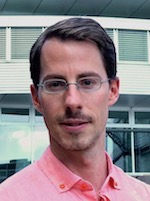
Claude Monney,
chair - PSI user
association JUSAP
|
|
Next proposal submission deadlines:
|
|
|
Isomer-Selective Generation and Spectroscopic Characterization of Biofuel Intermediates
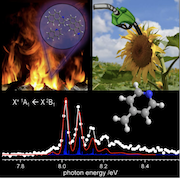 SLS - High-temperature chemistry of radicals SLS - High-temperature chemistry of radicals
Online combustion analysis relies heavily on spectral data to detect reactive intermediates isomer-selectively to establish e.g. kinetic flame models. Due to the difficulty to generate these species cleanly, spectral data are rather scarce. Here we report on the selective generation of three picolyl radical isomers (C5H4N-CH2*) by deamination of aminomethylpyridines. Picolyl radicals are relevant in biofuel combustion, and could now be characterized by threshold photoelectron spectroscopy using synchrotron radiation ...
Read the full story
|
|
|
E. Reusch et al, Angewandte Chemie Int. Ed., adv. online publication (2017)
|
|
|
Amyloid fibril systems reduce, stabilize and deliver bioavailable nanosized iron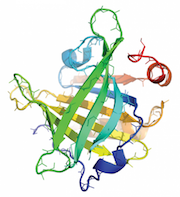
SINQ - SANS experiments help to fight IDA
Iron-deficiency anaemia (IDA) is a major global public health problem. A sustainable and cost-effective strategy to reduce IDA is iron fortification of foods, but the most bioavailable fortificants cause adverse organoleptic changes in foods. Iron nanoparticles are a promising solution in food matrices, although their tendency to oxidize and rapidly aggregate in solution severely limits their use in fortification. Amyloid fibrils are protein aggregates initially known for their association with neurodegenerative disorders, but recently ...
Read the full abstract
|
|
|
Y. Shen et al, Nature Nanotechnology, adv. online publication (2017)
|
|
|
Ground state selection under pressure in the quantum pyrochlore magnet Yb2Ti2O7
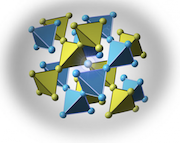 SμS - Spin liquid under pressure SμS - Spin liquid under pressure
A quantum spin liquid is a state of matter characterized by quantum entanglement and the absence of any broken symmetry. In condensed matter, the frustrated rare-earth pyrochlore magnets Ho2Ti2O7 and Dy2Ti2O7, so-called spin ices, exhibit a classical spin liquid state with fractionalized thermal excitations (magnetic monopoles). Evidence for a quantum spin ice, in which the magnetic monopoles become long range entangled and an emergent quantum electrodynamics arises, seems within reach. The magnetic properties ...
Read the full abstract
|
|
|
E. Kermarrec et al, Nature Communications 8, 14810 (2017)
|
|
|
Coherent structural trapping through wave packet dispersion during photoinduced spin state switching
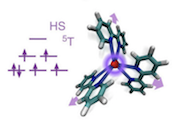 SwissFEL - Observing ultrafast dynamics of photofunctional molecules SwissFEL - Observing ultrafast dynamics of photofunctional molecules
Free electron lasers (FELs) like SwissFEL help scientists to understand the mechanisms that switch properties of materials which are the basis for functions in electronics, solar cells, chemistry and biology. By using ultrashort X-ray pulses it becomes possible to visualize the ultrafast rearrangements of electrons and atoms that enable the properties to switch in molecules or crystals. An international consortium of researchers lead by the Paul Scherrer Institute, Université de Rennes, and SLAC National Laboratory has now visualized the entire cascade of processes that lead to a change of the magnetic moment of electrons in a molecule within one trillionth of a second (10-12 s = 1 picosecond), using the FEL at Stanford, California (LCLS).
Read more.
|
|
|
H.T. Lemke et al, Nature Communications 8, 15342 (2017)
|
|
|
Comparison of ultracold neutron sources for fundamental physics measurements
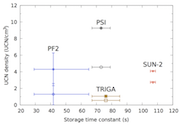 Particle Physics - UCN performance Particle Physics - UCN performance
Ultracold neutrons (UCNs) are key for precision studies of fundamental parameters of the neutron and in searches for new charge-parity-violating processes or exotic interactions beyond the Standard Model of particle physics. The most prominent example is the search for a permanent electric-dipole moment of the neutron (nEDM). We have performed an experimental comparison of the leading UCN sources currently operating. We have used a “standard” UCN storage bottle with a volume of 32 liters, comparable in size to nEDM experiments, which allows us to compare the UCN density available at a given beam port.
Read the full story
|
|
|
G. Bison et al, Physical Review C 95, 045503-1 (2017)
|
|
|
RIXSCam - the new CCD camera for RIXS at the ADRESS beamline
SLS
Recently, a new Electron Multiplying (EM) CCD camera has been installed into the RIXS spectrometer at the ADRESS beamline X03MA. This CCD camera comprising 3 CCD chips with a pixel size of 16 micron, called RIXSCam from XCAM Ltd. in UK, has been optimized for single photon counting. Through photon event centroiding it is thereby possible to achieve depending on the photon energy a spatial resolution of below 4 micron. This allows now to perform RIXS experiments with an energy resolution improved by about 30% and with triple of the total intensity of the previously installed CCD camera.
|
|
20 years of SINQ user operation
SINQ
In 1997 the Swiss spallation neutron source SINQ started user operation and PSI has celebrated the 20th anniversary of SINQ with a scientific symposium on April 18, 2017 together with many colleagues from Switzerland and abroad.
At the symposium it was not only looked back at past achievements, also recent scientific highlights were presented as well as the SINQ neutron guide and instrument upgrade program that will make SINQ fit for the next 20 years. Finally, the symposium also marked the change of the NUM Division Head from Kurt N. Clausen to Christian Rüegg. Read more.
|
|
Operation with 6cm target E
SμS
Since recently, the proton beam is restricted to 1.8 mA to limit the maximum beam power intensity on the SINQ spallation target. The corresponding decrease in data taking rate could be compensated at least for the muon instruments connected to the production target E. Here the installation of a 6 cm long target instead of the previously used 4 cm target resulted in an increase of 40% in muon rate per proton current in the πE3 and μE4 experimental areas.
The recent proposal round in June 2017 provided a total of 93 proposals. In particular, GPS is heavily demanded with 40 proposals. The beamtime request are under evaluation now and the users will be informed about the results during the next weeks.
|
|
First lasing at a wavelength of 4.1 nm
SwissFEL
The electron beam energy of SwissFEL was recently increased to above 900 MeV by successfully bringing two new accelerating modules into operation. This allowed SwissFEL to produce laser radiation for the first time in the soft X-ray regime with a photon wavelength of 4.1 nm. During the next months, the electron beam energy will be progressively further increased with the goal of enabling first user experiments at a wavelength of around 0.5 nm towards the end of this year. Read more.
|
|
New infrastructure and area control and access system for πE5
Particle Physics
The new layout of the πE5 experimental area taking account of the future μ3e experiment with its Compact Muon Beamline (CMBL) in the front part of the πE5 area and the MEG II experiment in the rear part of the area required new infrastructure as well as a total revision of its PSYS area control and access system. The implementation of the PiE5 area infrastructure modifications started with the winter shutdown this January.
Due to the great effort of the involved PSI infrastructure groups the modifications, in particular the new infrastructure platforms and the so-called “Skywalk” for their access, as well as the new μ3e control room and server room are now all in place. The new PSYS-system was successfully tested and inspected by the Ministry of Health (BAG). The new infrastructure as well as the new area control and access system represent a substantial step forward for the future experimental activities in πE5 area.
|
|
Editorial
Dear colleagues

The mission of the Joint Users’Association at PSI is to represent users at the large scale facilities of PSI. We, the JUSAP committee, can act as a link between the users and the management of PSI facilities. I encourage you, members of the PSI user community, to communicate to us any issues, concerns or suggestions. In this case, please contact me directly or other committee members. The next meeting of the JUSAP committee will take place in autumn 2017.
On May 1st, 2017, the CALIPSOplus project has started for a duration of 4 years. The kick-off meeting of the project took place on May 18-19, 2017 in Helmholtz-Zentrum Dresden-Rossendorf (HZDR, Germany). Funding of transnational access projects to accelerator-based light sources in Europe is available for the users again. Within the framework of CALIPSOplus, the user community, through the European Synchrotron and FEL User Organisation (ESUO), is going to realize various networking activities such as: (i) the establishment of contacts and sharing of best practice with other important user communities, (ii) the increase of the network of ESUO user delegates, (iii) the co-organisation of outreach events dedicated to users from less active areas (twinning program), (iv) the promotion of the gender balance in the light sources user community, (v) the further co-development of the wayforlight portal. For more details, please contact directly our ESUO delegate, Annick Froideval.
Various major upgrades of both SINQ and the High Intensity Proton Accelerator (HIPA) facility will result in shortened operation cycles in 2018 and there will be only one SINQ call for proposals in 2018. In 2019, SINQ will be not operational at all. In addition, during the period 2018-2019, HIPA will be operated with a reduced beam current. Users of SINQ, SμS and particle physics facilities should therefore plan ahead and be aware that calls for proposals may be rescheduled and less beam time might be available.
Yours sincerely,
Claude Monney,
on behalf of the JUSAP committee
|
|
Erice School on Neutron Science and Instrumentation: Neutron Precession Techniques
July 1-8, 2017, Erice, Sicily, Italy
MAGIC-2017: Magnonics, Interactions and Complexity: a multifunctional aspects of spin wave dynamics
July 2-6, 2017, Poznan, Poland
NOP2017: International Conference on Neutron Optics
July 5-8, 2017, Nara Kasugano International Forum, Japan
ICNS 2017: 9th International Conference on Neutron Scattering
July 9-13, 2017, Daejeon Convention Center, Korea
UK Colloids 2017
July 10-12, 2017, Manchester, UK
NTTI2017: New Trends in Topological Insulators
July 16-21, 2017, Congressi Stefano Franscini, Monte Verita, TI, Switzerland
International Conference on Strongly Correlated Electron Systems
July 17-21, 2017, Prague, Czech Republic
NXS 2017: National School on Neutron and X-ray Scattering
August 5-19, 2017, Argonne (IL) and Oak Ridge (TN), USA
Magnonics 2017
August 7-11, 2017, Oxford, UK
Neutron Scattering Applications to Hydrogen Storage Materials
August 7-17, 2017, Berlin, Germany
LT28: 28th International Conference on Low Temperature Physics
August 9-16, 2017, Gothenburg, Sweden
Microscopy Conference 2017
August 21-25, 2017, Lausanne, Switzerland
Joint Annual Meeting of the Swiss and Austrian Physical Societies - SPS and ÖPG
August 21-25, 2017, Geneva, Switzerland
DyProSo 2017: Dynamical Properties of Solids
August 27-31, 2017, Cracow, Poland
PSI Master School 2017
September 4-15, 2017, Villigen, Switzerland
21st Laboratory Course Neutron Scattering
September 4-15, 2017, Jülich and Garching/Munich, Germany
more events
|
|
|
|